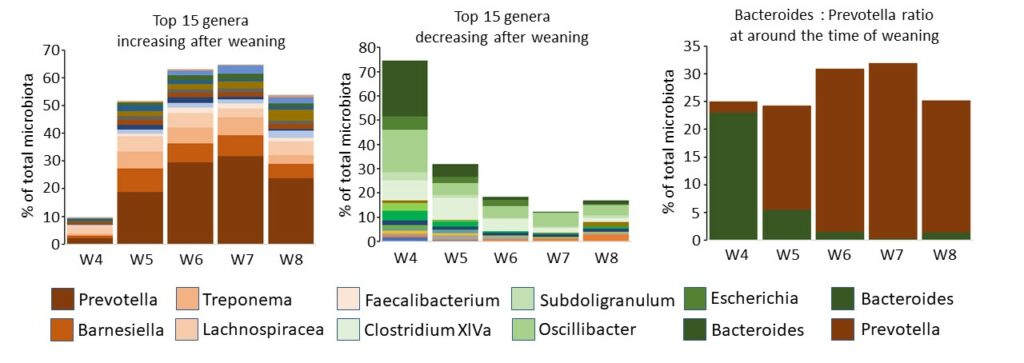Gut microbiota of piglets is subjected to extensive reshaping at the time of weaning (for details see HERE or HERE). As shown at the figure below, faecal samples were taken from 4-week-old piglets just before weaning and then in weekly intervals up to week 8 of life of piglets (W8). Gut microbiota composition was analysed in all collected samples by sequencing of V3/V4 variable region of 16S rRNA gene. Data showed that reshaping of gut microbiota composition was quite extensive and rapid. Gut microbiota restructured within one week after weaning and it is not surprising that there might be cases when the re-shaping is not optimal and postweaning diarrhoea are encountered. TOP 15 genera, abundance of which decrease after weaning, include Bacteroides, Escherichia, Oscillibacter, Subdoligranulum, Clostridium XlVa, Succiniclasticum, Pyramidobacter, Dorea, Ruminococcus, Pseudoflavonifractor, Fusobacterium, Desulfovibrio, Parabacteroides, Clostridium XI or Butyricimonas. On the other hand, bacterial genera, abundance of which increase after weaning include Prevotella, Barnesiella, Treponema, Lachnospiracea incertae sedis, Faecalibacterium, Blautia, Paraprevotella, Phascolarctobacterium, Butyricicoccus, Roseburia, Coprococcus, Anaerophaga, Megasphaera, Erysipelotrichaceae incertae sedis or Catenibacterium. Novel types of probiotics for weaned piglets can be sought especially among isolates and species from these genera. The most characteristic feature of gut microbiota before and after weaning is the replacement of two related genera, Bacteroides characteristic for nursed piglets and Prevotella characteristic for weaned piglets and adult pigs. These two genera commonly form around 25 % of total gut microbiota of pigs, though with clear dominance of Bacteroides in nursed piglets and clear dominance of Prevotella.
